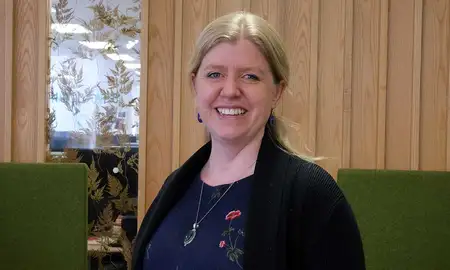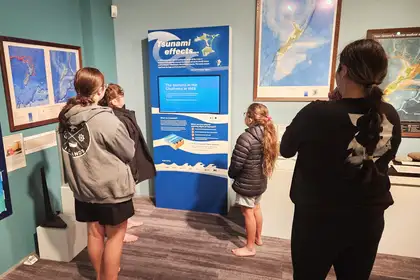
Local children inspect the new tsunami exhibition at the Chatham Museum.
The exhibition is a collaborative effort between Toka Tū Ake Earthquake Commission (EQC) and Te Kunenga ki Pūrehuroa Massey University’s Joint Centre for Disaster Research, with the aim of preventing a repeat of the deadly impact from the tsunami that struck on 14 August 1868. Following a magnitude 8.5-9.5 earthquake off the coast of South America, several six-metre waves claimed over 20 lives on the Chatham Islands.
The residents were woken by the initial six-metre wave, which was followed by two more even bigger waves within a 15-minute span which destroyed the communities. The Māori settlement at Tupuangi was hit the hardest, with entire whānau and whare being swept away, resulting in the tragic loss of life and the destruction of homes and crops.
Director of the Joint Centre for Disaster Research Professor David Johnston and his team developed the display with experts from the Institute of Geological and Nuclear Sciences (GNS Science), EastCoast Lab and the National Institute of Water and Atmospheric Research (NIWA).
The state-of-the-art display, which is located at the Chatham Museum, illustrates the journey of the waves generated by the Arica earthquake more than 150 years ago, demonstrating how they took 18 hours to travel across the Pacific Ocean to reach New Zealand’s most eastern outpost around 1am.
Professor Johnston says the work has been a collaborative effort.
“After our team formed the ideas for the display, they were then digitally designed by Wellington company Dusk and built into a display by Toulouse, who are one of Te Papa’s exhibit partners.”
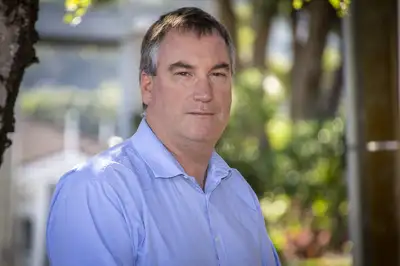
Director of the Joint Centre for Disaster Research Professor David Johnston.
The idea behind the exhibition is to teach locals and visitors how to understand the hazard of a tsunami and be prepared, as the Chatham Islands could be impacted again by South America or by the Hikurangi Subduction Zone.
Toka Tū Ake EQC Public Education Manager Hamish Armstrong says it’s important for Chatham Islands locals to be educated as they’re exposed to tsunami.
“Most Kiwis may have heard the evacuation messages about “Long and Strong, Get Gone”, but this exhibition really brings that message home for Chatham Islanders as it shows what the tsunami scenario would look like in their own backyard.”
Professor Johnston says it’s imperative that communities know how to recognise warning signs for the natural events they’re most exposed to and know the appropriate course of action.
“Being prepared for natural disasters is not just about safeguarding lives and property; it’s about ensuring the resilience of communities. The technology used in this exhibition offers a glimpse into the future of disaster preparedness and it would be great to see it leveraged across the country for various events. It has huge potential to mitigate risks and enhance response strategies across the motu.”
Learn more about the exhibition here.
Related news
Relationships key to tsunami preparedness
Three Massey researchers have been investigating what lessons can be learned from the resilience of rural communities and what information and resources they need to prepare for tsunamis.
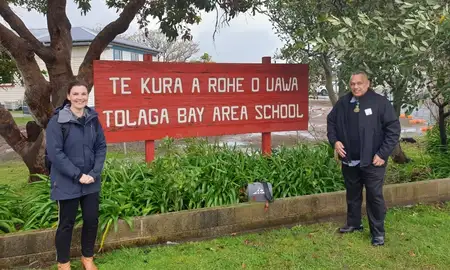
Annual virtual field trip shows tsunami impact on Chatham Islands
Students, along with their teachers, can now digitally explore Rēkohu Wharekauri/Chatham Islands and learn about the impact of past tsunami as part of the latest Toka Tū Ake EQC online field trip through LEARNZ.
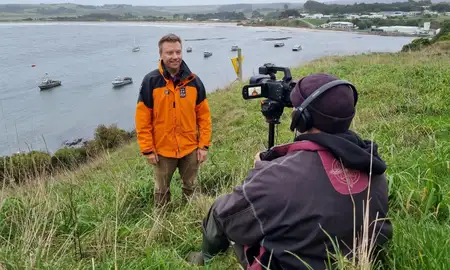
New partnership between Joint Centre for Disaster Research and Earthquake Commission
The Joint Centre for Disaster Research (JCDR) has developed a new partnership with the Earthquake Commission (EQC) to drive collaboration, coordination and alignment in disaster research.
